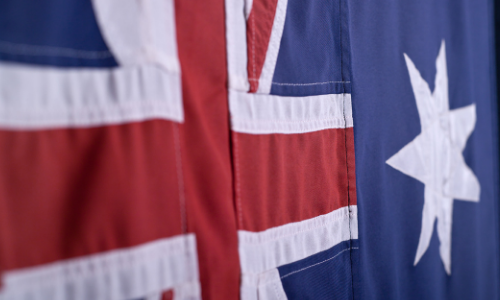For years the Australian flag has been flown as a way to show pride in our nation and respect for our heritage. At the dawn of the 20th Century the Australian flag was created. An international contest was held, resulting in 32,822 entries. Seven judges representing Army, Navy, Mercantile Marine, Pilot Services and Parliament unanimously selected the same design. And so ‘the flag of stars’ was born.
The Flag of Stars
A flag representing the history, distinctiveness and beauty of Australia. The Union Jack was included to reflect the new Federation’s historical background, the Southern Cross its place in space, and the large star the six States making up the Federation. (In 1908 the Government decided that a seven-pointed star, symbolic of the six States and the Territories, should replace the large six-pointed star shown in the original design of the Flag – to represent the Territories and to conform with the Star in the Crest of the Coat of Arms granted that year.)
In 1947, then Prime Minister J.B. Chifley issued a statement encouraging that there be no restriction on the flying of the Commonwealth Blue Ensign. For many years the Commonwealth Blue Ensign had been regarded as an official flag, with its use restricted to Government establishments. It was now encouraged to be used in public, by schools and private citizens, provided it was flown in an appropriate manner.
In 1951 King George VI approved the Government recommendation that the Commonwealth Blue Ensign be officially instated as the Australian Flag.
The Rules
The Australian National Flag should only ever be displayed in a manner befitting the national emblem. Meaning that it should never be “subjected to indignity”, or “displayed in an inferior position to any other flag or ensign”, and it should always be flown “aloft and free”.
To fly a flag upside down is a well known distress signal. Therefore the Australian National Flag must not be flown with the Union Jack down, unless as a signal of distress.
It’s important to note that when a flag becomes worn out or dilapidated and is no longer suitable for use, it should be destroyed in a dignified way, meaning it should be burned privately.
Half Masting
Flags are flown at half mast, as a sign of mourning. This is why, on Anzac Day the flag must fly at half mast, from dawn until noon. It is appropriate to fly the flags of New Zealand, the United Kingdom and other allied nations alongside the national flag. It is also considered appropriate to wave small Australian flags as marchers in Combined Service Parades pass.
The flag is brought to half-mast by first hoisting it to the peak for a moment and then slowly lowering it to half-mast.


